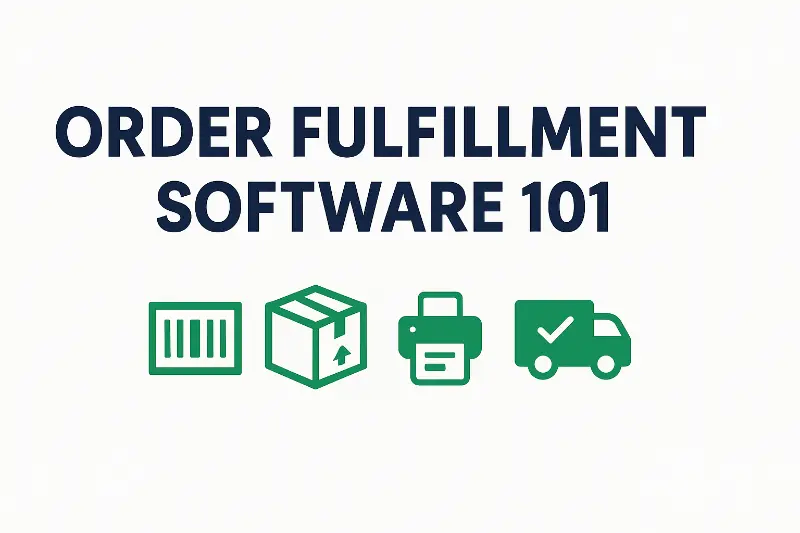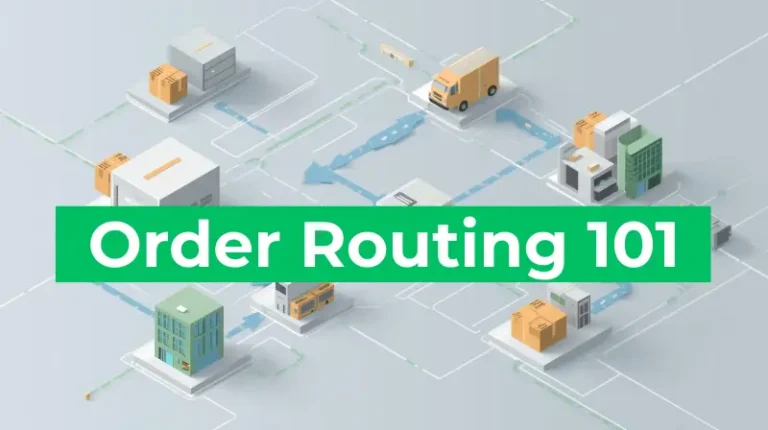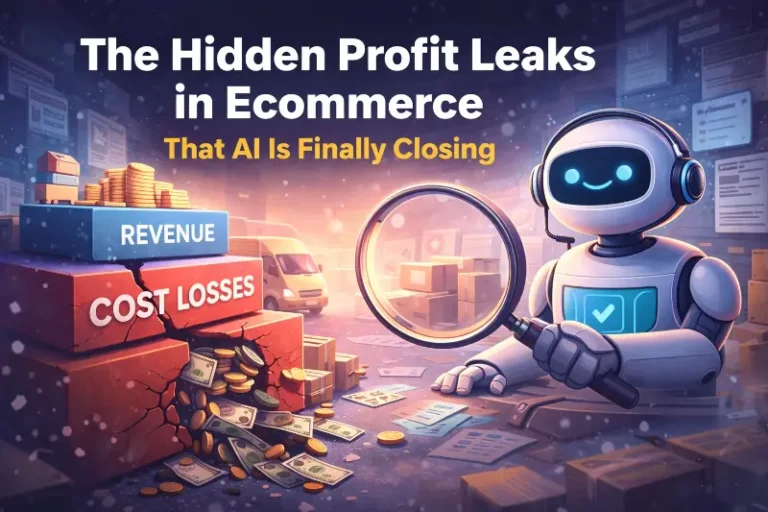What Is Order Fulfillment Software, And When Do You Actually Need It

Last updated on August 20, 2025

If spreadsheets still run your pick lists, you are paying a silent tax. Order fulfillment software turns chaos into routing logic. Businesses of all sizes, from small businesses to large enterprises, can benefit from order fulfillment software.
It decides where to ship from, creates shipping labels automatically, and feeds tracking back to customers and support, improving the customer experience and increasing customer satisfaction. The result: fewer clicks, fewer errors, lower shipping costs.
Using the right technology streamlines the delivery process and helps businesses fulfill orders faster.
Slash Your Fulfillment Costs by Up to 30%
Cut shipping expenses by 30% and boost profit with Cahoot's AI-optimized fulfillment services and modern tech —no overheads and no humans required!
I'm Interested in Saving Time and MoneyPlain English Definition
Order fulfillment software connects sales channels to your logistics operations. It automates the entire fulfillment process from order ingest to warehouse allocation, picking, packing, label creation, and tracking. Order management and order processing are central to the order fulfillment process, ensuring that each step, from receiving a sales order to preparing and shipping the product, is handled efficiently and accurately. Think of it as the brain that routes customer orders to the right fulfillment center and shipping service so you hit delivery times without overspending.
Where people get confused is in the alphabet soup. An OMS manages orders across channels. A WMS runs the inside of a building. Fulfillment software sits in the middle. It knows your inventory levels and shipping preferences, manages sales orders, and streamlines fulfillment operations and processing by deciding which warehouse should fulfill, calling the carrier APIs to print shipping labels, and pushing real-time updates back to your ecommerce platform.
What Good Fulfillment Software Actually Does
- Centralizes orders from all sales channels into a single dashboard with real-time data, low stock alerts, and robust inventory management features. Easily track inventory and monitor stock levels across multiple channels and warehouses.
- Allocates to the best node using rules about delivery times, shipping costs, inventory, and service level.
- Automates labels and documents, including packing slips and customs forms.
- Tracks orders in real time at every stage of the fulfillment process and updates customers automatically through your preferred channels.
- Surfaces exceptions for manual review only where needed, so manual data entry disappears.
- Drives efficiencies by automating and optimizing fulfillment operations, streamlining processes, and maximizing supply chain performance.
When You Truly Need It
You can hustle with one warehouse and one channel. But you actually need a fulfillment solution when any of these tripwires hit.
- Multiple warehouses or strategically located fulfillment centers.
- Two or more major sales channels.
- Delivery speed promises that vary by zone.
- Volume spikes around major sales events that break manual processes.
- Frequent out-of-stocks that require backorder logic and transparent ETAs.
- Handling a high volume of online orders from multiple online retailers.
If two or more are true, stop winging it. The cost of mis-picks, shipping with the wrong carrier, or missing two-day delivery speeds is bigger than the software subscription. Efficient fulfillment operations and a well-integrated supply chain are essential for maintaining customer loyalty as your business grows.
Looking for a New 3PL? Start with this Free RFP Template
Cut weeks off your selection process. Avoid pitfalls. Get the only 3PL RFP checklist built for ecommerce brands, absolutely free.
Get My Free 3PL RFPThe OMS Versus WMS Question You Will Ask
You will ask whether you need an OMS, a WMS, or both. The short answer. OMS orchestrates orders across channels and locations. A WMS runs the inside of a building, handling warehouse management such as inventory control, order processing, and warehouse operations. Many brands run both, with fulfillment software tying them together and talking to carriers. An order fulfillment solution streamlines order processing between OMS and WMS, ensuring efficient and accurate handling of customer orders.
Features That Move The Needle
- Smart routing and rate shopping to reduce shipping costs while meeting delivery expectations.
- Real-time inventory sync and low stock alerts to protect customer trust and avoid overselling.
- Voice picking support to boost pick speed and accuracy up to material levels when paired with a capable WMS.
- Native shipment tracking for real-time shipment tracking and updates after products are shipped.
- Efficiently ship products with confirmation and status updates when orders are shipped, ensuring transparency and timely delivery.
- Audit trails across order details, allocation decisions, and exceptions for informed decisions later.
A Starter Architecture For Small Business To Mid-Market
- Sales channels. Major ecommerce platforms and marketplaces. This architecture is ideal for small businesses looking for scalable and affordable solutions.
- Fulfillment brain. Your order fulfillment software with rules for shipping operations, carrier selection, and SLA guardrails. The software manages sales orders, tracks them through the fulfillment process, and automates the creation of packing slips for each sales order, streamlining order processing and improving accuracy.
- Nodes. One to three fulfillment centers to start.
- Data flow. Single dashboard for real-time insights, full control of shipping labels, and simple returns routing. The system provides visibility into all sales orders, from processing to delivery, helping small businesses monitor and manage orders efficiently.
Cahoot helps small businesses through enterprise clients manage sales orders efficiently and automate packing slip generation. The point is not the brand. It is the design. Choose software that exposes events, automates the label pipeline, and scales to new sales channels without custom projects.
Scale Faster with the World’s First Peer-to-Peer Fulfillment Network
Tap into a nationwide network of high-performance partner warehouses — expand capacity, cut shipping costs, and reach customers 1–2 days faster.
Explore Fulfillment NetworkThe Cahoot View
Cahoot’s software was built to cut shipping costs by routing orders to the closest, best node across our fulfillment partners. This approach drives efficiencies and streamlines fulfillment operations for ecommerce businesses by optimizing order routing, inventory management, and shipping processes. You get one login, a single dashboard, and real-time updates. When your ecommerce business adds multiple warehouses or new sales channels, you do not rewire your store. You flip a switch.
Frequently Asked Questions
How Is Fulfillment Software Different From OMS And WMS?
OMS manages the order lifecycle across channels. WMS manages the warehouse floor. Fulfillment software sits between them to allocate orders and create labels while feeding tracking back to customers.
Will It Actually Reduce Shipping Costs?
Yes, if it routes the order to the closest node and rate shops carriers automatically. Software that cannot rate shop or apply shipping preferences consistently will not move the needle.
Do I Need This With Only One Warehouse?
Not always. But once your business starts to scale, for example, you add more sales channels, add a second node, or promise faster delivery times, manual allocation becomes error-prone and expensive.
How Does Voice Picking Fit?
Voice picking lives inside the WMS. Your fulfillment software should pass clean pick lists to a WMS that supports voice so you gain speed and accuracy benefits.
What Integrations Matter Most?
Direct connections to your ecommerce platform, carriers for labels, and a tracking layer like Cahoot for real-time updates. Without these, your “automation” still depends on manual data entry.

Turn Returns Into New Revenue


 6 minutes
6 minutes


